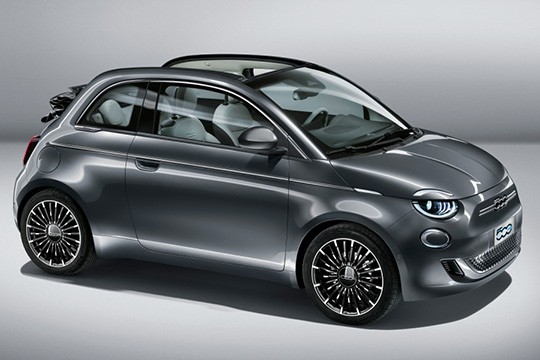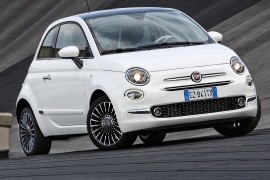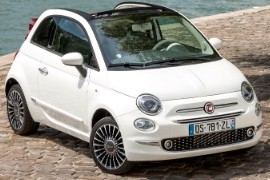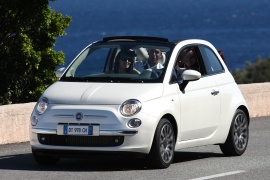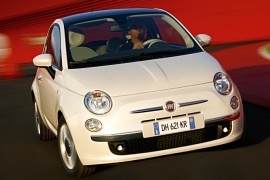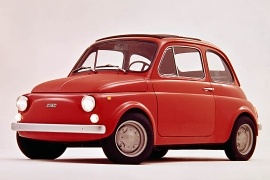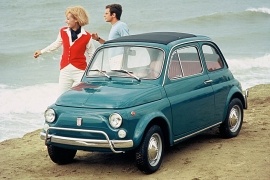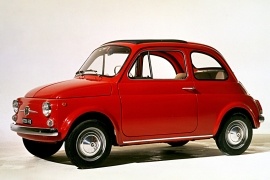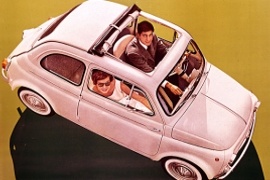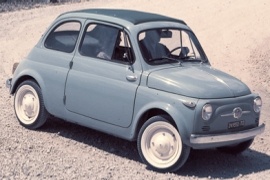FIAT 500 Models/Series Timeline, Specifications & Photos
First production year: 1957
Engines: Electric, Gasoline, Diesel
Body style: Hatchback
The Fiat 500 is not a car anymore. It is an icon of the European automotive industry, the car that helped Italy to grow more than six decades ago. The original design was re-mastered and, just like a black&white classic movie when it is colorized, the 500 was reinvented and brought back to the main automotive scene in 2007. Nowadays, the electric motor is the only one available on the little Italian car.
The 500 dropped its internal combustion engines and adopted an 87 kW electric motor, which is fed from a 42 kWh lithium-ion battery. The plug is in the rear side of the vehicle and the battery ensures a range of up to 320 km in the WLTP cycle. This power unit is enough for a 0 to 100 kph (0-62 mph) sprint in 9 seconds flat and a 0 to 50 kph (0-31 mph) acceleration time of just 3.1 seconds. The top speed is limited to 130 kph (93.2 mph).
Inside the vehicle there are a lot of recycled materials, since the Fiat 500 has also become a statement of sustainability. A 7” TFT plays the dashboard role and works together with a 10.25” Touch Screen infotainment display.
The vehicle has multiple ways of charging and it comes as standard with a charging device, which can be plugged-in at home or in any regular 220v socket. An optional charging wall-box is provided for faster charging. In fast-charge mode, at public charging stations, it can be charged up to 80% in 35 minutes.
The little Fiat 500 was sold in over 1.5 million units before it received an ample refresh in 2015. With its charm and a nimble ride, the 500 received numerous updates inside and out.
The Fiat 500 might be called the Fiat brand savior. The charming little car was charming enough to bring back the Fiat brand in the U.S. And it was received as a fashion item more than a transportation device. Despite its small engines and lilliputian size, it fitted well between the big SUVs such as its relatives from RAM.
The 2016 Fiat 500 received a new design for the headlights and taillights. It also received LED daytime running lights, a feature that was not mandatory when the car was introduced to the market in 2007. The taillights were unique on the market, with the actual light encircling a body part. The reversing light and the rear fog-light were placed on the lower part of the bumper with a long chromed line between them.
Inside, the 500 featured a new infotainment unit of 5” that featured a touch-screen for the Lounge trim level. It was unusual for a car to feature a touch-screen smaller than a smartphone screen. An optional 7” display was available for the instrument cluster.
Under the hood, the 2016 Fiat 500 featured a 0.9-liter turbocharged engine with two cylinders and a 4-cylinder, naturally aspirated 1.2-liter unit. A 6-speed manual was fitted as standard while a 5-speed automatic was offered as an option. For the diesel fans, a 1.3-liter unit was available.
Fiat relaunched the 500 series in 2007, after 32 years of absence on the market with an inspirational design based on the original car's look.
In 2015, Fiat applied a facelift for its city car. Along with the rest of the range, the Italian carmaker upgraded the convertible version as well. Even though it was more of an open-top vehicle rather than a genuine convertible, the 500C distinguished itself as the smallest 4-seat rag-top vehicle on the market.
Most of the 500C buyers would say that the car is cute. Its rounded shapes mimicked the original 500 design, but in a modern reinterpretation. Its headlights were still circular but slanted to create a dynamic appearance, while the LED daytime running lights found their way in the lower cluster. Its roof was power-operated and retractable behind the rear seats. It didn't disappear behind the bench but stayed in plain sight.
Inside, Fiat improved the infotainment system with an option for a 5" touch-screen mounted on the center stack. It was Bluetooth compatible and sported a USB connection to play music from a regular memory stick. Thanks to a redesigned dashboard, the facelifted version of the 500C was modern but still resembled the original model.
Under the hood, Fiat offered a choice of four options, ranged between 69 hp and 105 hp. The acclaimed 0.9-liter TwinAir was mated to a 6-speed manual in the top-spec version, while the carmaker fitted a 5-speed manual for the rest of the range.
While it wasn't a complete cabriolet, the 2009 Fiat 500C was still a pleasant view on the street with its charming design enhanced by the pleasure of driving under the open sky in a so-called, top-cabriolet.
The 500C was unveiled at the 2009 Geneva Motor Show and resembled the image of the original, 1957, Fiat 500. The car was available in the showrooms starting with the 4th of July, the birthday of Fiat. The car was created after extensive researches among the Fiat car communities by the Centro Stile Fiat.
The design started with the normal, closed, version of the 500. It was noticed that the customers loved the profile of the car and that made the designers think to keep it. It also was cheaper to design and produce the car while keeping the side panels and the security arches over the doors and side windows. The 500C was not exactly a convertible, but more of a top-cabriolet vehicle. The short hood, round headlights, and all the other recognizable details were kept.
Inside, the two-tone upholstery and the two-tone dashboard completed the fancy image of the little Fiat 500C. A long list of market-dependent standard and optional features was available: from automatic climate control to the innovative Interscope HiFi System, from the Blue&Me Map portable navigation unit to the smart wind-stop.
The Fiat 500C shared all three of the regular 500 power units: the 75 HP 1.3-liter MultiJet turbodiesel engine combined with a five-speed manual gearbox and the two 69 HP 1.2-liter and 100 HP 1.4-liter gasoline engines, both available with manual or Dualogic robotized gearbox.
Fiat revived the 500 nameplate in 2007, bringing back one of its best-selling models of all times, and replacing it with a new top-seller.
Half a century after introducing the first Cinquecento (500), the Italian carmaker introduced a new generation for the supermini vehicle. After sending home prominent car designers who tried to pen the new model, Roberto Giolito made it at the Centro Stile Fiat.
A successful design is considered one that doesn't need a badge and can still recognize the model. This was the Fiat 500. Its short nose with big, round headlights and no grille between them was characteristic for the 1957 model, and the same went for the 2007 car. The carmaker installed a different grille in the lower part of the wrapped-around plastic bumper, placed below a horizontal chromed slat that mimicked the older metallic bumper from the original model. Its raked and tall windshield started the greenhouse design, which was arched toward the back of the tilted-forward back of the car.
Inside, Fiat continued the retro-design theme and installed a flat dashboard, but with modern features. The tall center stack hosted the gear stick on the lower side while the audio system occupied the upper area. Inside the instrument cluster, the carmaker placed a wide speedometer with an LCD in the middle for other onboard computer information. Depending on the trim level, a hand-stitched leather-clad steering wheel indulged the driver. The 500 offered four seats inside the cabin, but none of them were comfortable for tall drivers.
Under the hood, the carmaker installed a wide engine choice. At the launch, there were only a few four-cylinder versions available. Later on, the carmaker installed a two-cylinder turbocharged 0.9-liter unit, a turbo-diesel, and several other turbocharged gasoline powerplants.
It was time to say goodbye to the beloved Fiat 500, but the Italian manufacturer did that in style with the last version, named Rinnovata.
Maybe the 500 was not the car that saved Fiat, but it surely helped it grow on a market where the running costs were important, and it did it with a charming look and an interior fit for two adults and two kids in the back. The rear engine construction helped the car to turn on a dime and handle well.
After the rear-hinged doors were banned from production, Fiat changed them with front-hinged ones (regular), which brought some critics from its customers. The Rinnovata, or R, was built with the same front fascia as the D model, with a simple chromed bumper at the front. Above that, on the fenders, the carmaker installed a set of simple, round, turn-signals. The 500 R was easy to recognize from other models since it didn't feature a chromed badge on the front panel.
The interior was carried over from the L-version (Lusso – Luxury) with vinyl covered seats and a small tray in front of the floor-mounted gear-stick. There were pockets on the doors and vinyl-covered door panels.
Fiat installed a bigger engine in the back, which was used in the larger Fiat 126. Unfortunately, it kept the same 4-speed un-synchromesh gearbox from its predecessors.
The 500 was already a massive success on the market, and Fiat didn't know what to do to make more money from it. So, it imagined a luxury version named 500 L (Lusso – Luxury).
In 1968, the Italian carmaker already made the car with front-hinged doors, and it was considered safe again. After introducing the D series and the F (Family) series, the marketing department noticed that many customers asked for more refinement from their 500s. The little Fiat was already a gadget and received a status icon.
It installed a second metallic bumper in front of the regular, wrapped-around, chromed metallic bumper, for starters. The designers used the same round turn-signals from the 500 F and its doors. While the F/Berlina was designed as a middle trim-level, the L was the full-options version.
Inside, there was the same minimalist design concept as on the rest of the range. It featured vinyl (leatherette) seats and padded door panels. The metallic, trapezoidal instrument cluster sported a speedometer and a few warning lights for fuel, charging, and oil pressure. The steering wheel sported two twin-spokes.
Under the hood, the 500 L carried over a de-tuned version of the 500 cc engine from the 500 Sport. Its power was reduced to 18 hp from 21 hp to increase the fuel-efficiency.
Fiat 500 was a huge success, and the Italian carmaker constantly improved the car. In 1965 it introduced the F/Berlina version.
The rear-hinged doors started to be phased out by the carmakers due to safety reasons. Fiat followed that trend for its entire lineup, and it was the time for the 500 model to be changed. But the carmaker couldn't do that overnight and started to introduce them on facelifted versions such as the F/Berlina.
Fiat introduced the 500 F in 1965, and it represented a middle trim level for the small-segment Italian vehicle. Its lifespan spread across the 500 D (the last version with suicide-doors) and the L (Lusso – Luxury). It looked almost identical to the rest of the range, and it was available either with a solid roof or canvas top. A 500 F might be recognized by its round, orange, turn-signals mounted on the front fenders, similar to those from the D-version and, unlike the F-version, it sported a single front-bumper design.
Inside, there was the same minimalist design concept as on the 500 F. It featured vinyl (leatherette) seats and padded door panels. The metallic, trapezoidal instrument cluster sported a speedometer and a few warning lights for fuel, charging, and oil pressure. Unlike the rest of the range, it was fitted with a new steering wheel with two metallic spokes.
Under the hood, the 500 D carried over a de-tuned version of the 500 cc engine from the 500 Sport. Its power was reduced to 18 hp from 21 hp to increase the fuel-efficiency.
Introduced in 1960 as a replacement for the 500 Nuova range, the 500 D was the last of its kind to feature suicide doors.
Three years after its introduction on the market, the 500 evolved into a trendy vehicle. In the beginning, it started as an Italian city commuter car, but it was demanded in other markets as well. The 500 D was sent as CKD in New Zeeland and assembled locally, and filled the market with the little 2-cylinder vehicle.
Fiat introduced the 500 Nuova (New) in 1957 and, three years later, it upgraded it to the D-model. It looked almost identical, but it featured a solid roof. For those who preferred the open-top, the Italian carmaker offered a canvas-top version named Transformable. A 500 D might be recognized by its round, orange, turn-signals mounted on the front fenders, instead of the teardrop-shaped ones from the Nuova. Apart from the Family (Giardiniera) version, it was the last to feature rear-hinged doors.
Inside, there was the same minimalist design concept as on the 500 Nuova. It featured cloth seats in the front and a bench for two in the back. The metallic dash panel sported a speedometer and a few warning lights for fuel, charging,and oil pressure.
Under the hood, the 500 D carried over a de-tuned version of the 500 cc engine from the 500 Sport. Its power was reduced to 17 hp from 21 hp to increase the fuel-efficiency.
In 1957 Fiat introduced a successor for the 500 Topolino, and the result exceeded even the most optimistic ideas, while the 500 Nuova became the best-known Fiat of all times.
Before WWII, Fiat introduced a popular vehicle named 500 but known everywhere as Topolino, which was the Italian nickname for Mickey Mouse. After the war, the Italian carmaker couldn't do anything else and continued producing the vehicle, which was originally introduced in 1936. It was already an outdated vehicle two decades later, and Fiat desperately needed a replacement for it. Then, the 500 Nuova (New) arrived, and everything changed.
With its Lilliputian size and happy face, the 500 was a hit right from day one. Its front fascia featured a wide metallic panel since the engine was in the back, and there was no need for a grille at the front. The designer installed the tear-shaped turn signals on the sides, close to the front fenders' top. Its narrow chromed metallic bumper was slightly arched in front of the front panel.
Inside, the car sported a minimalist design concept. It featured cloth seats in the front and a bench for two in the back. The metallic dash panel sported a speedometer and a few warning lights for fuel, charging, and oil pressure. Since it had to be a very affordable vehicle, Fiat didn't bother to install door-pockets or other comfort features. Under the front hood, the carmaker placed the trunk, which was large enough for a small suitcase.
Since Italy needed a very fuel-efficient engine, Fiat offered a 500 cc unit that provided just 13 hp. It was enough to move the 470 kg (1,036 lbs) vehicle. Later on, a Sport version came on the market and provided 22 hp. Both versions were paired to a four-speed manual gearbox.
